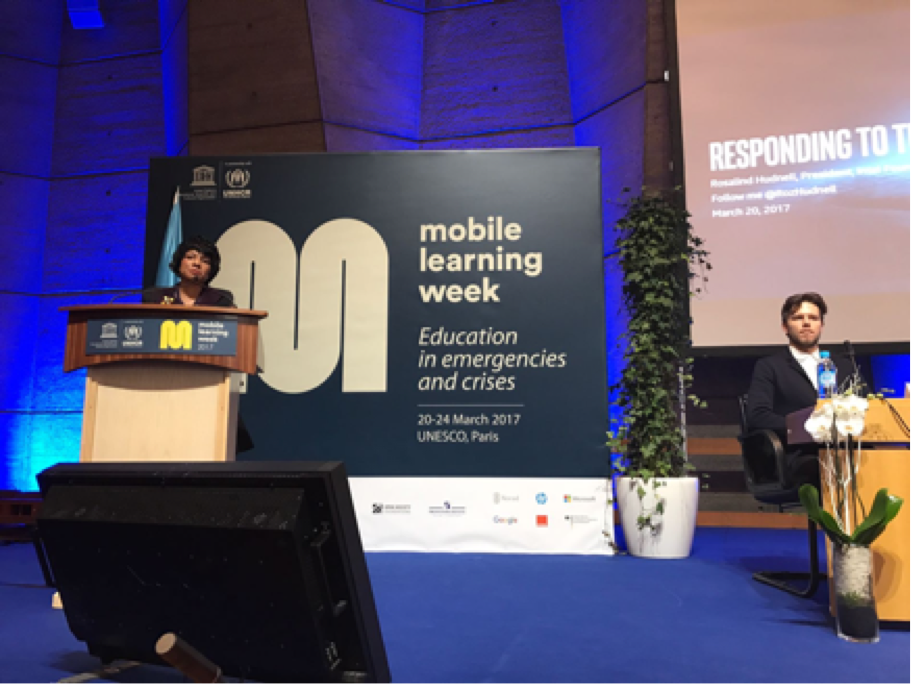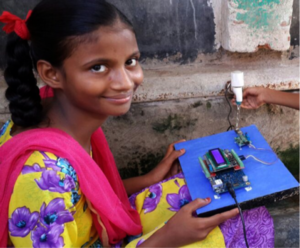Responding to the Global Youth Crisis

Rosalind Hudnell, Vice President of Corporate Affairs at Intel Corporation and President of the Intel Foundation, giving keynote address at Mobile Learning Week on Monday, March 20, 2017. (Photo by Intel)
“Young people should be at the forefront of global change and innovation. Empowered, they can be key agents for development and peace. If, however, they are left on society’s margins, all of us will be impoverished. Let us ensure that all young people have every opportunity to participate fully in the lives of their societies.”- Kofi Annan
For nearly two decades, I have been honored to lead various efforts at Intel focused on providing access and opportunity to young people facing inequalities, so that they could improve their everyday lives. Being on the precipice of the Fourth Industrial Revolution, where digitization and automation is driving the economy, it is imperative now more than ever before that we are equipping young people with the right skills to solve the problems they and their communities face. Today there are about 300 million 15-to-24 year olds not working.[1] It is our responsibility to help change this reality. And as Kofi Annan wisely said, solving the challenges of the next generation must include them at the center of the solutions.
This past week I attended UNESCO’s Mobile Learning Week and had the opportunity to give a keynote address as to why it is necessary for organizations to work together to respond to the global youth crisis. Currently, young people are almost three times more likely to be unemployed than adults and they are continuously exposed to lower quality of jobs, greater labor market inequalities, and longer/more insecure school to work transitions.[2] Moreover, one third of the 65.3 million refugees around the world are youth under the age of 18.[3] The skills required for the future must support an increasingly connected workplace where products, services, and businesses will operate in the cyber-physical world. Youth will need a combination of technology skills, soft skills, life skills, financial literacy, and the ability to continuously develop and improve their capabilities. Mentors and environments of support will still be needed to succeed. However, without a systemic focus, we risk millions of the youth from diverse communities and diverse backgrounds continuing to not be able to fully participate. We need collective action to close the youth skills gap.
Intel has a long history of investing in education and young people. Now we are building on that experience by providing technology skills and implementing innovative models to ensure that young people have the critical thinking skills, design knowledge, and prototyping ability to secure the jobs of the future. We must work to redefine what it means to be an innovator by expanding who has access to technology skills and experiences. The next generation of innovators must be more diverse in terms of geography, economic status, ethnicity, and gender in order to harness the full power of technology to create the best future possible for everyone.

A young girl in Bawana, India built a water quality monitoring device in a tinkering lab that allows her community to check their water supply to ensure it is safe to drink. (Photo by Intel)
In India, we are working with the government through our Intel® Future Skills program to inspire one million young people to be innovators and to solve social problems by building 500 tinkering labs with coaches, training, content, and process knowhow. The locations of the tinkering labs were selected with inclusivity in mind—we are not only bringing tinkering labs to densely populated areas in India. We are also bringing tinkering labs to remote areas to ensure we include the hardest to reach populations in order to make a real impact. The first tinkering lab successfully launched this month, which comprised of 40 girls. With the Indian government’s partnership, all 500 tinkering labs will be open and functional by the end of 2017.
In the United States, we are collaborating with a workforce development partner to pilot an Intel® Future Skills program that will prepare youth from disadvantaged backgrounds for the jobs of tomorrow. We are leveraging Intel’s leadership by focusing on drone technology and a geography that is a federally funded and government approved to test drones in order to transform job training. Our first class graduated with 260 hours of hands on training in areas such as robotics, 3D printing, laser cutting, UAS Safety, flight dynamics and simulators, and analytics and diagnostics. They each also experienced relevant classes in business acumen, critical thinking, public speaking, as well as a variety of opportunities to work in teams to improve collaboration skills. Ninety-five percent of the first graduate class were able to secure new jobs or return to their current jobs with broader skillsets and increased responsibilities. We believe that by collaborating with new partners, finding innovative ways to meet youth where they are, and creating training content that is geographically relevant to the opportunities emerging is a necessity and a model we can build from.
The youth employment gap is a crisis that needs to be solved collectively, with bold contributions from the technology companies that are driving the innovation, and working in partnership with governments, foundations, and NGOs that bring resources and subject matter expertise on these issues. There are 300 million and growing young people waiting for us. It’s time we answer their call.
[1] The Economist. “Generation Joblessness.” April 27, 2013. http://www.economist.com/news/international/21576657-around-world-almost-300m-15-24-year-olds-are-not-working-what-has-caused
[2] Abdelaziz, Maged. Officer of the Special Adviser on Africa. “World Youth Skills Day 2016: “Skills Development to Improve Youth Employment. July 15, 2016.http://www.un.org/en/africa/osaa/events/2016/youthskillsday2016.shtml
[3] UNHCR: The UN Refugee Agency. “Figures at a Glance.” 2016. http://www.unhcr.org/en-us/figures-at-a-glance.html
